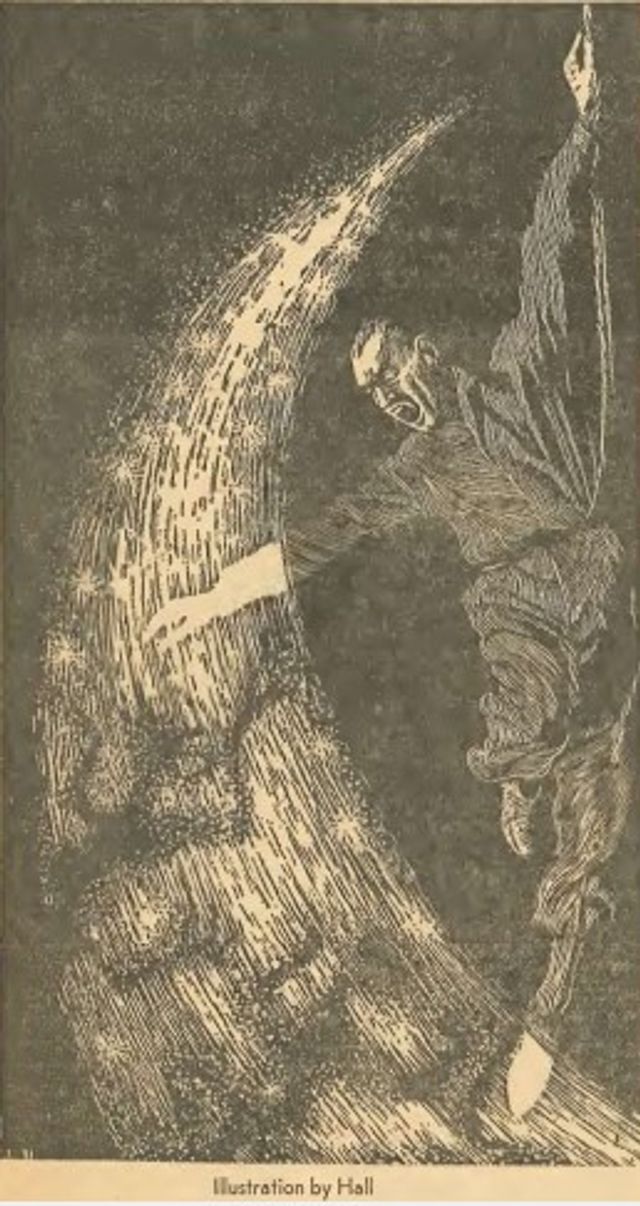-
Vijay Fafat
- Published on
This is the longer, later version of the story written by Robert Lowndes under a pseudonym, “Wilfred Owen Morley” (called “The Long Wall”, published in “Stirring Science Stories”, March 1942). Lowndes expanded that story into a novella, “Settler’s Wall”
The novella is a puzzle-tale about a one-sided wall near Flagstaff, Maine, describing events in circa 1934. The story predates AC Clarke’s story about a similar Mobius wall (“The Wall of Darkness”), though Clarke’s story is much richer in imagery and conception. It also reminds one of R. A. Lafferty’s story, “The Narrow Valley”.
The narrator, A, his cousin, Arthur Gordon, and a friend, Will Richards, headed for a CCC Summer camp. On the way, they come across an odd wall which seems to stretch for miles, with a very odd atmosphere around it. The narrator:
“I had the oddest feeling. I had seen this wall and yet not really noticed it, even though it extended as far as we could see in either direction. There were no markings on it visible from across the road; and when we got around to examining it close up, we found none still. Our guess that it was ten feet high turned out to be correct; and there it rose, dull, gray and well weathered. Within the range of our vision, there was not a single distinguishing sign; at no point did grass eclipse it, or vines, or trees. In fact, the grass ended just about a foot away from it, in as straight a line as one could imagine, and the well-packed earth between the end of the grass and the wall itself was perfectly clean.”
They decide to see how far it stretches. One thing leads to another and they find that not only is the wall somehow warping the entire topology of the neighborhood (so that a 9 minute straight walk along the wall brings you back to the start without having double-backed), it is also impossible to go over the wall (you come back on the same side) or throw objects to the other side. The story goes through a number of possibilities of penetrating to the other side of the wall, including taking aerial pictures, parashuting down to the other side and blowing a hole in it with dynamite. All they find is that either there is no other side to the wall, or that the hole in it keeps going into some other dimension. By the end of it, the narrator is convinced that this is some sort of a higher-dimensional construct with a single side - more than a Mobius strip, but what, he has no idea:
“Settler’s wall was not of stone, or any other substance we’re familiar with, though it seemed to be more nearly like stone than anything else. And there was some sort of phenomenon connected with it, as a result of which one could neither go around it or over it, nor through it— in fact, it seemed that there just wasn’t any other side at all. I’ve heard of Mobius strips, of course, but it couldn’t have been a Mobius strip.”
And then, in the hurricane of 1938, the wall simply disappears. The final line of the story implies that the wall may have actually been some sort of higher-dimensional creature which simply “swam away”…
Commentary: I should note that I would have considered this “mathfiction” even if the author had not mentioned Mobius strip. The geometry of the situation, taken in its entirety, convey a strong sense of a topology that does not fit Euclidean 3-space but of a spatial twist which is not explainable easily without a higher-dimensional construct. The fact that the author does not explicitly explain this the way many pulps do (line, square, cube, hypercube) does not make it less “mathfictiony” to me - indeed, I found it refreshing to have a story which played the air of a mathematical mystery without hammering home the point. Other stories, like Ted Chiang’s “Tower of Babylon”, R.A. Lafferty’s “The Narrow Valley”, Baxter’s “The Pacific Mystery”, AC CLarke’s “The Wall of Darkness” and a few others have a very similar feel even if they do not explicitly elucidate topological mathematics in the story-proper.
